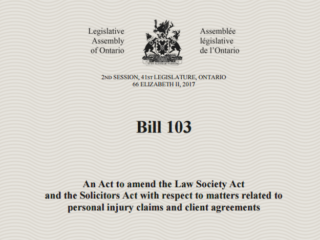The applicant, Vinh Thanh Du, was injured in an automobile collision on February 14, 2020. He sought benefits from his car insurer, Economical Insurance. Economical denied treatment plans for physiotherapy and massage therapy on the basis that the applicant’s injuries fall within the Minor Injury Guideline (“MIG”). A claimant is confined to the MIG if they sustain primarily minor injuries in the subject accident.
The Minor Injury Guideline
“Minor injury” is defined in the Superintendent’s Guideline No. 01/14 as a sprain, strain, whiplash associated disorder, contusion, abrasion, laceration or subluxation and any clinically associated sequelae. A claimant may also be removed from the MIG if they have a pre-existing medical condition, documented in the medical records, that would prevent the claimant from achieving maximal medical recovery within the $3,500 MIG limits.
In this case, the applicant attended the emergency department immediately after the collision. The attending physician diagnosed him with a concussion. Furthermore, his family physician completed a Disability Certificate (“OCF-3”) indicating that he sustained a concussion in the crash.
It is undisputed that if an insured sustains a concussion in a motor vehicle collision, their injury falls outside the MIG: Wadood v Economical Insurance, 2023 CanLII 9251 (ON LAT), Kolanski v. TD Insurance Meloche Monnex, 2021 CanLII 30824 (ON LAT), and 17-001473 v Unica Insurance Inc., 2017 CanLII 69462 (ON LAT).
The respondent argued that the emergency records contained a note stating, “no head injury” and the collision occurred at the low speed of 5 km/h, therefore it was not possible for the applicant to have sustained a concussion in the collision.
The Licence Appeal Tribunal (“LAT”) rejected the respondent’s position. The note about “no head injury” was in the subjective reports from the applicant, not the physician’s diagnosis. Also, if the respondent wanted to take a position that the speed of the collision was too low to have caused a concussion, it should have hired a biomechanical engineer to give that evidence. Otherwise, the LAT preferred the opinions of the emergency physician and the family physician.
Accordingly, the applicant was removed from the MIG.
The Denied Treatment Plans
The subject treatment plans were denied on the basis of MIG and did not provide any medical reasons. The applicant argued that there was no proper denial of the plans.
The respondent argued that the Ontario Court of Appeal decision of Varriano v. Allstate Insurance Company of Canada, 2023 ONCA 78 (CanLII) stands for the proposition that the insurer does not need to provide medical reasons if there are “other reasons” for a denial of benefits.
In Varriano, the Court of Appeal held that “and” in the phrase “medical and other reason” in s. 37(4) of the Statutory Accident Benefits Schedule (“SABS”) can include both the joint sense and the several sense, but when read contextually, the ordinary meaning of the word “and” was intended in its several sense.
The decision in Varriano is distinguishable from this case because Varriano dealt with denial of a specified benefit (e.g., an income replacement benefit) under s. 37, not a medical or rehabilitation benefit under s. 38 of the SABS. Adjudicator Neilson wrote:
If an insurer denies a treatment plan based on the MIG, there must be a medical reason – i.e. injuries or injury that is either a sprain, strain (injury to one or more tendons or ligaments, muscles including a partial but not a complete tear), whiplash associated disorder, contusion, abrasion, laceration or subluxation (partial but not a complete dislocation of a joint) and any clinically associated sequelae. Without such an explanation, the purpose of adding the medical or other reason requirement to s. 38(8) of the Schedule to allow an unsophisticated person to know why the benefits were denied is defeated. To simply say “your injury is minor” without describing what the applicant’s injuries are does not comply with s. 38(8) of the Schedule. [para 40]
Again, the respondent provided no medical reasons beyond stating that the applicant was in the MIG. Therefore, the denials were improper, and the respondent is required to pay for any expenses incurred under the disputed treatment plans from the 11th business day after the plans were received until a compliant denial is sent.
Other Preliminary and Procedural Issues
This decision also dealt with preliminary and procedural issues that may impact future LAT decisions.
- Preliminary Issue – Failure to Attend s. 44 Insurer Examinations
The respondent raised a preliminary issue wherein it asked the LATto bar the applicant from applying to the LAT on the denied treatment plans because he refused to attend s. 44 Insurer Examinations.
The LAT denied the request because the respondent did not raise the preliminary issue at the case conference or at any other point prior to the hearing. The respondent stated that the s. 44 request came late because the applicant was late in providing medical documentation. The LAT indicated that the respondent should have brought a motion to get an order for the medical documents it was waiting on and to add the preliminary issue. In these circumstances, any prejudice to the respondent was due to its own actions or in-actions.
To allow the late addition of the preliminary issue would amount to an abuse of process and would set the tone for a complete disregard of the LAT Rules of Practice and Procedure. As such, the LAT would only consider the issues outlined in the Case Conference Order.
- Procedural Issue – Excluding Clinical Notes and Records
The respondent sought to exclude the clinical notes and records from a rehabilitation company because they were ordered to be produced no later than December 26, 2022. However, they were not produced until July 23, 2023.
The motion was granted.
The applicant argued that he had made a request for records from the rehabilitation company in July 2022, but had been advised that there were no records. He asked again in July 2023 and received the records after pointing out that he had received treatment at the clinic and therefore there should be clinical notes and records.
Common Rule 9.4 provides the presumptive exclusion of evidence that has been disclosed late. Though the LAT agreed that the records may be relevant to the issue in dispute, there was no evidence of why the applicant failed to comply with the case conference order and waited until over eight months after the production deadline to make reasonable efforts to obtain the records. There was clear prejudice to the respondents. Beyond admission of evidence of the fact that the applicant did attend the clinic, the records were excluded.
Conclusion
If there is compelling medical evidence that an insured suffered a concussion or post concussion syndrome, they are out of the MIG. If the insurer wants to argue about biomechanics and causation to refute the medical evidence, it must hire an expert to provide the relevant opinion.
Parties should comply with the production deadlines and LAT Rules of Practice and Procedure or risk exclusion of important issues or evidence from their case.













